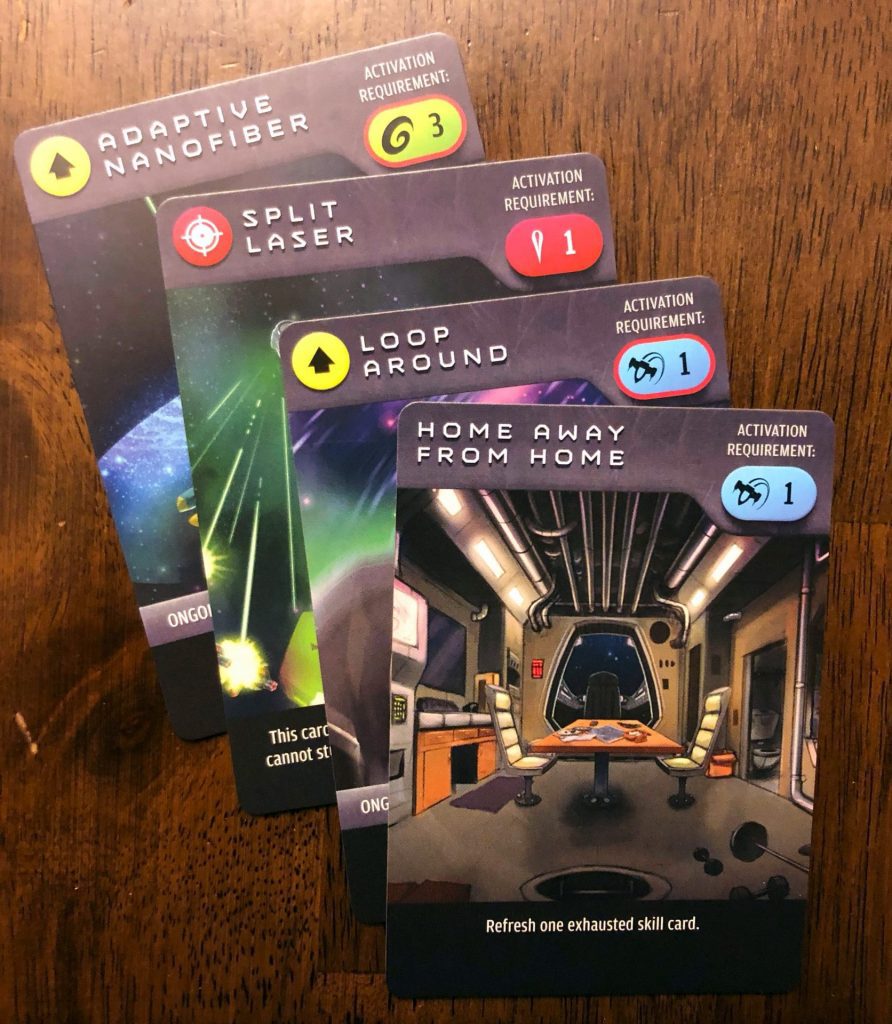Warp’s Edge, from prolific designer Scott Almes, is a solo-only bag-building adventure that puts you in the cockpit of an experimental spaceship. But don’t go flipping switches to see what happens just yet, because there’s a looming alien fleet coming in fast and it looks like they have a laser pointed directly at…
Darn. You’re dead. Fortunately, this state-of-the-art ship is equipped with warp technology unlike anything you’ve ever seen. When that engine kicks in, it can send you back in time to before your bird went belly-up. Unfortunately, it’s not entirely stable, so you’ve only got a few “warps” before the ship — and your body — falls apart completely. Make the most of your hard-earned knowledge to anticipate the enemy and eliminate the fleet!
Let’s Do the Time Warp Again
During each game of Warp’s Edge, the player must build up strength by accumulating various tokens representing spaceship actions: lasers, photon lasers, space…flips. They’ll use these tokens to blast through or dodge past enemy ships to get a clean line on the fleet’s Mothership. Take out the Mothership and the day is won.
However, the player only has a set number of Warps (rounds) to accomplish this mission. Each Warp resets the enemy fleet but also refreshes the player’s literal bag of tricks. A Warp consists of a variable number of turns based on how quickly the player burns through the tokens in their bag. As players accumulate more tokens through gameplay, Warps get progressively longer and players are able to put together powerful combinations to defeat their enemies.

One of the key selling points to Warp’s Edge is its variable setups. To start the game, the player must choose a unique spaceship to pilot and a Mothership to face off against. The player ships have varying hull and shield strengths as well as unique abilities. The Motherships are much more unique but generally feature three or more sections, each of which is a separate threat that must be defeated, as well as a few special rules. Each Mothership sports a difficulty rating to help guide the player’s decision. The player will also get a helpful skill card which can be activated (at a given cost) as well as a bag full of ten starter tokens and a single special token based on their chosen ship.

Tokens come in a few basic flavors: laser and energy (money) tokens are available in denominations of one, two, or three while maneuver tokens are only available in a value of one. The special tokens are sorted into five categories (labelled P, O, W, E, and R) with multiple options per category; each spaceship can access a specific and unique combination of these special tokens, one type for each of the categories. Two included trays hold the available tokens, making it easy to see at a glance what upgrades the player might make.

On the player’s turn, they’ll draw out five tokens from their bag and use them to destroy, evade, and stun the opposing ships. Enemy ships come in three strengths and the number of each is determined by the Mothership. At any time there are four enemy ships to fight, which replenish each turn should any be destroyed. Enemies have both a destroy value (how many lasers need to be spent to defeat the ship) and an evade value (same, but for maneuvers). Once that value is hit, the player collects the matching rewards — typically tokens added to their bag — and sends the enemy to the discard pile. These thresholds are cumulative; if a player can’t take an enemy out, they can still assign laser or maneuver tokens to the ship. Doing so stuns the enemy temporarily, preventing them from dealing damage to the player’s ship at the end of the round, and lets the player whittle a threat down over the course of a few turns. The player can also spend tokens to activate skills, buy more tokens, and repair their ship’s shields. Spent tokens are discarded to a separate area, rather than being returned to the bag, which nicely sets up the game’s Warp mechanic.

If a player can’t pull all five new tokens from the bag to start their turn, the current Warp ends. The player advances the Warp track, puts all their tokens back in the bag, and gains a new skill card. They also shuffle the current enemies in with the discarded ones and place all of those on top of any remaining in the deck, forcing the player to face the same foes once more. Thankfully, any damage dealt to the Mothership remains, though any damage dealt to the player’s ship also remains. Play continues in the same way until either the player’s ship explodes due to damage, the final Warp on the track ends, or the player defeats the Mothership.

Livin’ on the Edge
I love the story that Warp’s Edge tells. The overall arc of the game builds nicely. The first Warp or two let the player power up, while the later Warps become a mad dash to finish off the Mothership before time runs out. Those penultimate turns typically see increasingly complicated combos firing off to shred through the enemy defenses. The game’s central time-loop conceit actually works pretty well in the larger sense, making the player feel stronger with each successive jump. The enemies that were a struggle in earlier rounds become manageable and the looming Mothership eventually becomes a viable target rather than an insurmountable danger. When you string a series of plays together that lets you push past the enemy fleet and drop your heaviest hits on the Mothership, it’s deeply satisfying.
That sense of pacing doesn’t always carry over to the turn-to-turn gameplay. Don’t get me wrong: each turn presents a multi-layered puzzle with plenty of room for thought. The problem is that each puzzle uses the same limited set of pieces. Enemy ships tend to linger for a few turns in a stun-locked stasis while the player scrapes together enough tokens to make a big play, then reappear a few turns after their defeat as part of the next Warp. It’s repetitive by design. From a conceptual and thematic standpoint it makes perfect sense; from a mechanical perspective, it occasionally adds a bit of unwanted drag to the otherwise frictionless fun. There’s a reason that most time-loop stories avoid the tedious middle parts, and at times I wish Warp’s Edge had just a little less of that tedium because the first and final Warps are both so consistently excellent.

But the biggest head-scratcher in this box is the Singularity book by well-known writer/designer Banana Chan. This short booklet offers a choose-your-own-path story that helps players get into the game’s setting; by the end of it, they’ll also have a custom setup based on their choices in the narrative. I’m honestly not sure when I would need this. The game’s setup is not very complicated, nor does having a narrative behind the choices add much to the gameplay. Some of the paths in the fiction don’t contribute directly to setup at all, telling the player to “remember” something that ends up not being used in any noticeable way. And in many places the writing feels forced, a victim of the need to cram so much world-building into a game that doesn’t benefit from it. To be honest, I don’t think this is representative of Banana Chan’s otherwise excellent work and I’d just as soon throw the whole thing out. That’s a shame because Warp’s Edge invests so much in its theme and setting yet still doesn’t stick the landing.

I can’t help but compare Warp’s Edge to Under Falling Skies. Both are solo-only games with a sci-fi/alien fleet theme, variable setups, and gameplay focused around managing random results each turn. In my review of Under Falling Skies I declared that it might just be a perfect game, owing largely to its consistently tense turns and long-form campaign that builds player investment despite the occasionally dry gameplay. Warp’s Edge has a more unique concept, tells a better tale in each game, and features the charming tactility of a bag-builder. Depending on which of those sounds better, you might find Warp’s Edge eclipsing Under Falling Skies, though there’s room for both in any solo player’s collection.
For me, Warp’s Edge stops just shy of being a perfect game. It is, however, a great one despite a few flaws. I’ll happily take Warp’s Edge out for a spin again…and again…and again…and again…












Add Comment